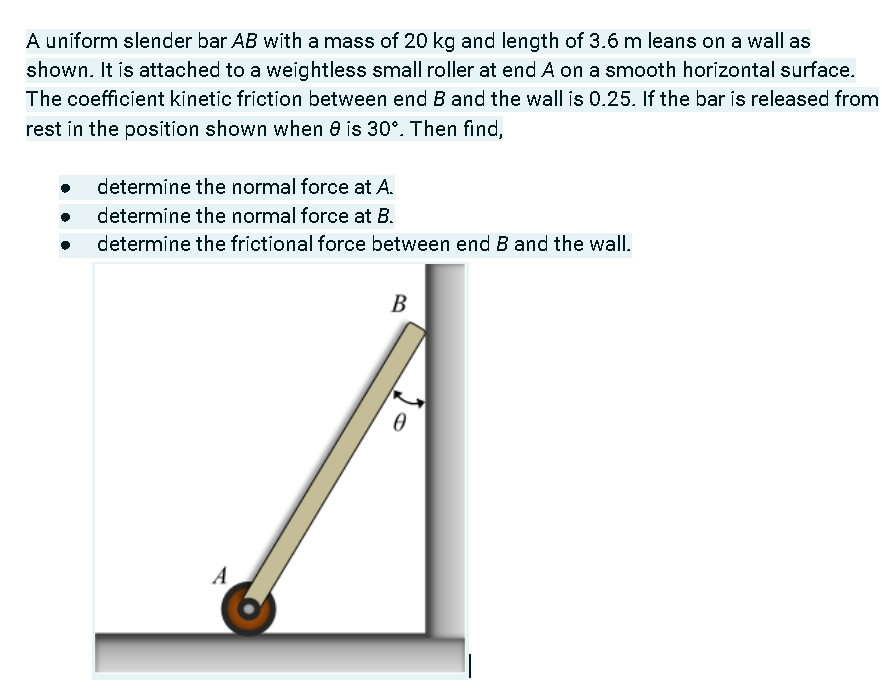A uniform slender bar AB with a mass of 20 kg and length of 3.6 m leans on a wall as shown. It is attached to a weightless small roller at end A on a smooth horizontal surface. The coefficient kinetic friction between end B and the wall is 0.25. If the bar is released from rest in the position shown when θ is 30°. Then find, determine the normal force at A. determine the normal force at B. determine the frictional force between end B and the wall.
A uniform slender bar AB with a mass of 20 kg and length of 3.6 m leans on a wall as shown. It is attached to a weightless small roller at end A on a smooth horizontal surface. The coefficient kinetic friction between end B and the wall is 0.25. If the bar is released from rest in the position shown when θ is 30°. Then find, determine the normal force at A. determine the normal force at B. determine the frictional force between end B and the wall.
International Edition---engineering Mechanics: Statics, 4th Edition
4th Edition
ISBN:9781305501607
Author:Andrew Pytel And Jaan Kiusalaas
Publisher:Andrew Pytel And Jaan Kiusalaas
Chapter7: Dry Friction
Section: Chapter Questions
Problem 7.3P: Two identical chairs, each weighing 14 lb, are stacked as shown. The center of gravity of each chair...
Related questions
Question
A uniform slender bar AB with a mass of 20 kg and length of 3.6 m leans on a wall as shown. It is attached to a weightless small roller at end A on a smooth horizontal surface. The coefficient kinetic friction between end B and the wall is 0.25. If the bar is released from rest in the position shown when θ is 30°. Then find,
- determine the normal force at A.
- determine the normal force at B.
- determine the frictional force between end B and the wall.

Transcribed Image Text:A uniform slender bar AB with a mass of 20 kg and length of 3.6 m leans on a wall as
shown. It is attached to a weightless small roller at end A on a smooth horizontal surface.
The coefficient kinetic friction between end B and the wall is 0.25. If the bar is released from
rest in the position shown when e is 30°. Then find,
determine the normal force at A.
determine the normal force at B.
determine the frictional force between end B and the wall.
B
A
Expert Solution
This question has been solved!
Explore an expertly crafted, step-by-step solution for a thorough understanding of key concepts.
This is a popular solution!
Trending now
This is a popular solution!
Step by step
Solved in 2 steps with 1 images

Knowledge Booster
Learn more about
Need a deep-dive on the concept behind this application? Look no further. Learn more about this topic, mechanical-engineering and related others by exploring similar questions and additional content below.Recommended textbooks for you

International Edition---engineering Mechanics: St…
Mechanical Engineering
ISBN:
9781305501607
Author:
Andrew Pytel And Jaan Kiusalaas
Publisher:
CENGAGE L

International Edition---engineering Mechanics: St…
Mechanical Engineering
ISBN:
9781305501607
Author:
Andrew Pytel And Jaan Kiusalaas
Publisher:
CENGAGE L